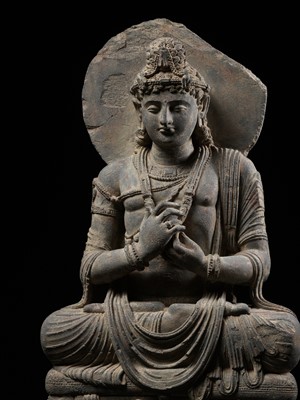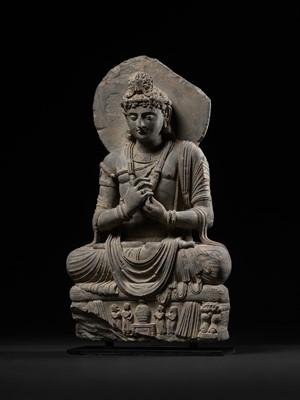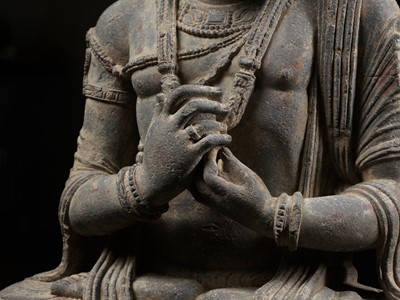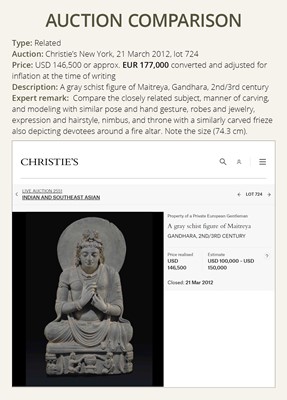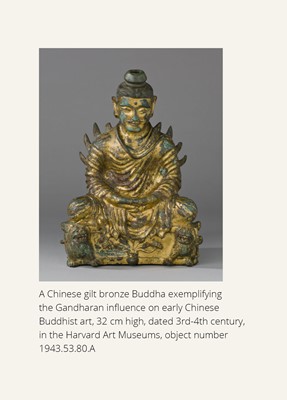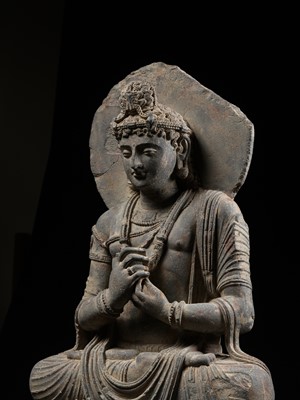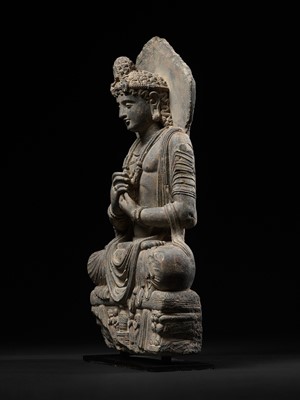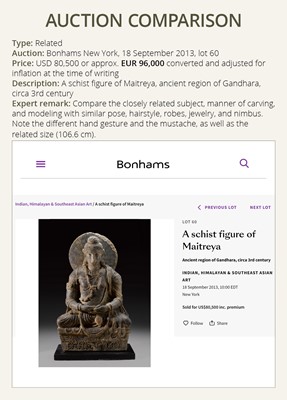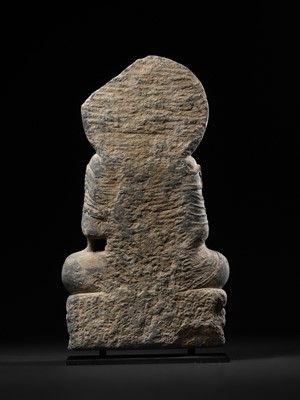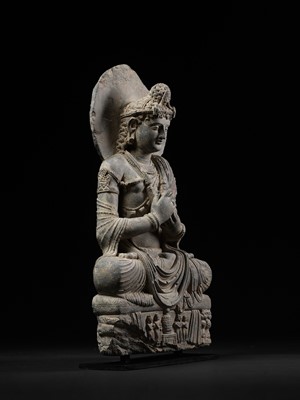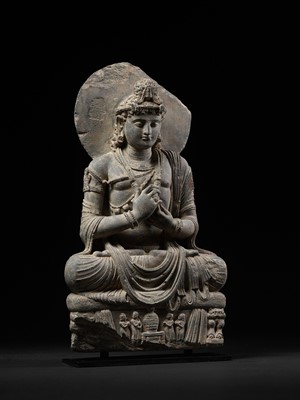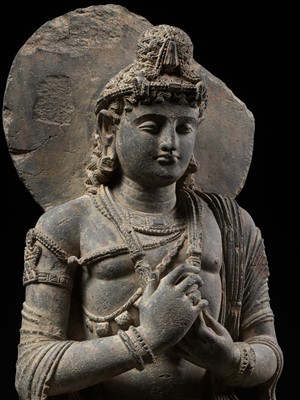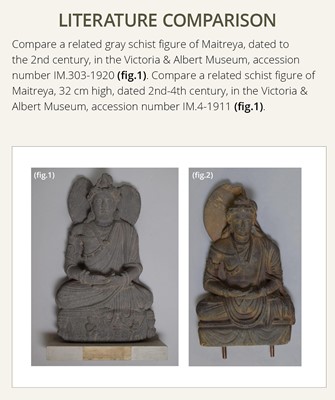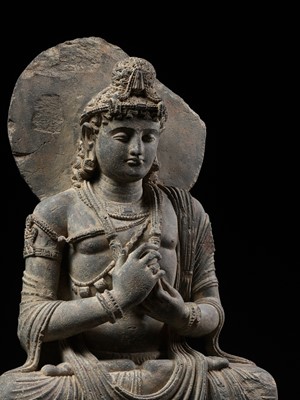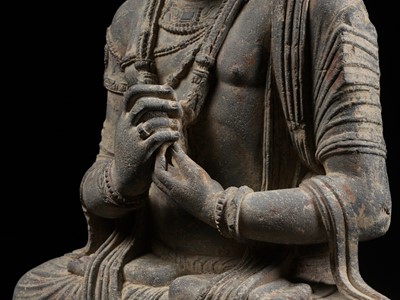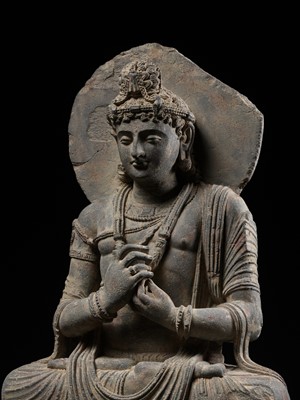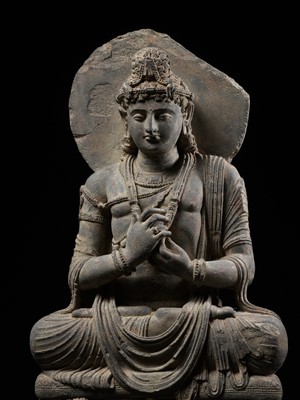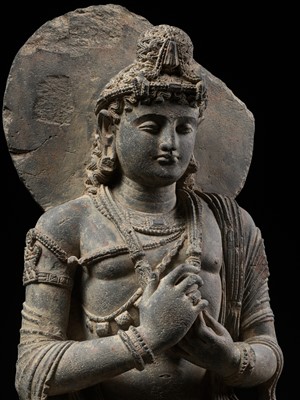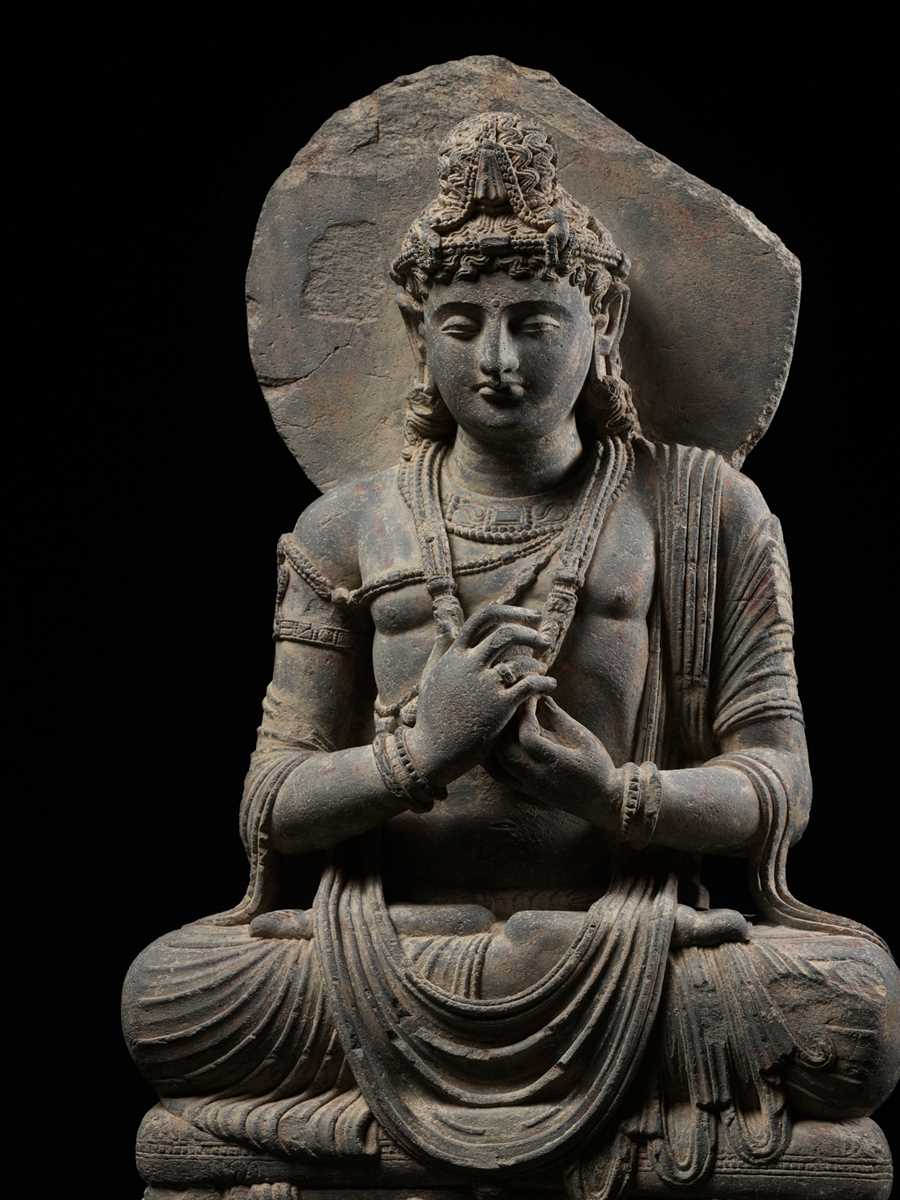11th Oct, 2023 11:00
THREE-DAY AUCTION - Fine Chinese Art / 中國藝術集珍 / Buddhism & Hinduism
230
A LARGE GRAY SCHIST FIGURE OF MAITREYA, KUSHAN PERIOD, ANCIENT REGION OF GANDHARA, CIRCA 3RD CENTURY
約西元三世紀犍陀羅貴霜帝國大型灰色片岩彌勒佛像
Sold for €127,600
including Buyer's Premium
Superbly carved, seated in dhyanasana with his hands held in dharmachakra mudra, dressed in a voluminous sanghati with exquisitely carved folds, elegantly pooling in concentric rings at his ankles and spilling over the edge of the base, bedecked with various necklaces including a large choker with inset design and talismanic armlets. His serene face with heavy-lidded almond-shaped eyes below gently arched brows centered by a raised urna, secured by an elaborate headdress comprising a network of beads interlinked between horizontal bands that rest above the forehead and wrap around the ushnisha.
Provenance: From an old Belgian private collection. Acquired before 1970 and thence by descent in the family.
Condition: Good condition, commensurate with age. Extensive wear, obvious losses, nicks, scratches, signs of weathering and erosion. A few structural cracks with associated losses, some of which show old restoration.
Weight: 148 kg
Dimensions: Height 109.5 cm (incl. stand) and 105.5 cm (excl. stand)
Please click here to read the full description
Maitreya is backed by a halo and his throne is carved with a frieze depicting two devotees on either side of a fire altar flanked by zoomorphic columns.
With consummate skill, the sculptor has achieved a majestic enthroned Maitreya. The marvelous naturalism conveyed throughout the torso and robe, as the latter slackens and contorts around the powerful figure, is a testament to the virtuoso who carved it. With a broad muscular torso, strong hands, and ornate stylized folds, this large sculpture exhibits the power and authority of Maitreya, believed to reside in Tushita heaven until the time comes when Shakyamuni is no longer remembered and the future Buddha will need to be reborn.
As Mahayana Buddhism spread from Gandhara to China, images of Maitreya became the focal point of a widespread cult, the idea of a messianic savior appealing to many living under the chaotic political climate and civil unrest of the Six Dynasties period that followed the collapse of the Western Han Dynasty in the beginning of the 3rd century - the time around which this sculpture was made. The link between the art of Gandhara and early Buddha images in China is demonstrated through a direct comparison of the facial features and robes between the present lot and a gilt bronze Buddha held in the Harvard Art Museums, object number 1943.53.80.A, which is among the earliest devotional Buddhist images made in China.
Literature comparison:
Compare a related gray schist figure of Maitreya, dated to the 2nd century, in the Victoria & Albert Museum, accession number IM.303-1920. Compare a related schist figure of Maitreya, 32 cm high, dated 2nd-4th century, in the Victoria & Albert Museum, accession number IM.4-1911. Compare two sculptures of youthful bodhisattvas also displaying the teaching mudra, see I. Kurita, Gandharan Art, vol. II, Tokyo & New York, Tokyo, 2003, pp. 53 & 57, nos. 128 and 141.
Auction result comparison:
Type: Related
Auction: Christie’s New York, 21 March 2012, lot 724
Price: USD 146,500 or approx. EUR 177,000 converted and adjusted for inflation at the time of writing
Description: A gray schist figure of Maitreya, Gandhara, 2nd/3rd century
Expert remark: Compare the closely related subject, manner of carving, and modeling with similar pose and hand gesture, robes and jewelry, expression and hairstyle, nimbus, and throne with a similarly carved frieze also depicting devotees around a fire altar. Note the size (74.3 cm).
Auction result comparison:
Type: Related
Auction: Bonhams New York, 18 September 2013, lot 60
Price: USD 80,500 or approx. EUR 96,000 converted and adjusted for inflation at the time of writing
Description: A schist figure of Maitreya, ancient region of Gandhara, circa 3rd century
Expert remark: Compare the closely related subject, manner of carving, and modeling with similar pose, hairstyle, robes, jewelry, and nimbus. Note the different hand gesture and the mustache, as well as the related size (106.6 cm).
点此阅读中文翻译 (Chinese Translation)
約西元三世紀犍陀羅貴霜帝國大型灰色片岩彌勒佛像
描述:雕刻精美,彌勒結跏趺坐,雙手結説法印,穿著寬大的外袍,衣紋流暢,優雅地在腳踝處匯聚成同心環,並垂于底座邊緣;戴耳璫、項圈、聖線、飾線、臂釧、腕釧等飾物。用連珠髮帶扎束,髮型捲曲,梳理有序垂於兩肩。他額部較寬,眉間白毫,深目、高鼻、薄唇,上唇有髭鬚,顏貌端正無比。
來源:比利時私人舊藏。 1970 年之前購得,此後家族傳承。
品相:狀況良好,大面積磨損、明顯缺損、刻痕、劃痕、風化和侵蝕跡象。一些結構裂縫,有小修。
重量:148 公斤
尺寸:高 109.5 厘米 (含底座),高 105.5 厘米 (不含底座)
彌勒佛後有光背。精湛的技藝,成就了一尊威嚴的彌勒坐像。這座大型彌勒造像擁有寬闊、肌肉發達的軀幹、有力的雙手,展示了彌勒佛的力量和權威。彌勒佛被認為是未來的佛陀。當佛法在人間被遺忘時,他將從他所居住的兜率天降生到我們的世界,成為下一任佛陀。當彌勒佛出生時,身著高貴豪華的殊妙服飾,流露王侯貴族的王子氣派,無疑是悉達多太子成佛前菩薩裝扮的完美體現。在健陀羅時期,彌勒被認為是最重要的菩薩。
隨著大乘佛教從犍陀羅傳到中國,彌勒佛像成為崇拜的焦點。三世紀初的西漢時期——該造像的製作時間。通過將本拍品與哈佛藝術博物館收藏的鎏金青銅佛像(藏品編號 1943.53.80.A)的面部特徵和袈裟進行比較,展示了健陀羅藝術與中國早期佛像之間的聯繫。
文獻比較:
比較一件相近的西元二世紀彌勒佛灰色片岩,收藏於維多利亞和阿爾伯特博物館,館藏編號IM.303-1920。比較一件相近的二至四世紀彌勒佛片岩,高32 厘米,收藏於維多利亞和阿爾伯特博物館,館藏編號IM.4-1911。比較兩件年輕菩薩像,見I. Kurita,《Gandharan Art》,卷II,東京&紐約,2003年,頁53 & 57,編號128和141。
拍賣比較:
形制:相近
拍賣:紐約佳士得,2012年3月21日,lot 724
價格:USD 146,500(相當今日EUR 177,000)
描述:二至三世紀犍陀羅彌勒佛灰色片岩
專家註釋:比較非常相近的主題、雕刻風格,以及造型和手勢、長袍和珠寶、表情和髮型、靈氣和帶有類似雕刻楣的寶座也描繪了火壇周圍的信徒。請注意尺寸 (74.3 厘米)。
拍賣比較:
形制:相近
拍賣:紐約邦翰斯,2013年9月18日,lot 60
價格:USD 80,500(相當今日EUR 96,000)
描述:約西元三世紀犍陀羅彌勒佛灰色片岩
專家註釋:比較非常相近的主題、雕刻風格,以及姿勢、髮型、袍服、珠寶、靈氣相似的造型。請注意不同的手勢、鬍鬚和相近尺寸 (106.6 厘米)。
Superbly carved, seated in dhyanasana with his hands held in dharmachakra mudra, dressed in a voluminous sanghati with exquisitely carved folds, elegantly pooling in concentric rings at his ankles and spilling over the edge of the base, bedecked with various necklaces including a large choker with inset design and talismanic armlets. His serene face with heavy-lidded almond-shaped eyes below gently arched brows centered by a raised urna, secured by an elaborate headdress comprising a network of beads interlinked between horizontal bands that rest above the forehead and wrap around the ushnisha.
Provenance: From an old Belgian private collection. Acquired before 1970 and thence by descent in the family.
Condition: Good condition, commensurate with age. Extensive wear, obvious losses, nicks, scratches, signs of weathering and erosion. A few structural cracks with associated losses, some of which show old restoration.
Weight: 148 kg
Dimensions: Height 109.5 cm (incl. stand) and 105.5 cm (excl. stand)
Please click here to read the full description
Maitreya is backed by a halo and his throne is carved with a frieze depicting two devotees on either side of a fire altar flanked by zoomorphic columns.
With consummate skill, the sculptor has achieved a majestic enthroned Maitreya. The marvelous naturalism conveyed throughout the torso and robe, as the latter slackens and contorts around the powerful figure, is a testament to the virtuoso who carved it. With a broad muscular torso, strong hands, and ornate stylized folds, this large sculpture exhibits the power and authority of Maitreya, believed to reside in Tushita heaven until the time comes when Shakyamuni is no longer remembered and the future Buddha will need to be reborn.
As Mahayana Buddhism spread from Gandhara to China, images of Maitreya became the focal point of a widespread cult, the idea of a messianic savior appealing to many living under the chaotic political climate and civil unrest of the Six Dynasties period that followed the collapse of the Western Han Dynasty in the beginning of the 3rd century - the time around which this sculpture was made. The link between the art of Gandhara and early Buddha images in China is demonstrated through a direct comparison of the facial features and robes between the present lot and a gilt bronze Buddha held in the Harvard Art Museums, object number 1943.53.80.A, which is among the earliest devotional Buddhist images made in China.
Literature comparison:
Compare a related gray schist figure of Maitreya, dated to the 2nd century, in the Victoria & Albert Museum, accession number IM.303-1920. Compare a related schist figure of Maitreya, 32 cm high, dated 2nd-4th century, in the Victoria & Albert Museum, accession number IM.4-1911. Compare two sculptures of youthful bodhisattvas also displaying the teaching mudra, see I. Kurita, Gandharan Art, vol. II, Tokyo & New York, Tokyo, 2003, pp. 53 & 57, nos. 128 and 141.
Auction result comparison:
Type: Related
Auction: Christie’s New York, 21 March 2012, lot 724
Price: USD 146,500 or approx. EUR 177,000 converted and adjusted for inflation at the time of writing
Description: A gray schist figure of Maitreya, Gandhara, 2nd/3rd century
Expert remark: Compare the closely related subject, manner of carving, and modeling with similar pose and hand gesture, robes and jewelry, expression and hairstyle, nimbus, and throne with a similarly carved frieze also depicting devotees around a fire altar. Note the size (74.3 cm).
Auction result comparison:
Type: Related
Auction: Bonhams New York, 18 September 2013, lot 60
Price: USD 80,500 or approx. EUR 96,000 converted and adjusted for inflation at the time of writing
Description: A schist figure of Maitreya, ancient region of Gandhara, circa 3rd century
Expert remark: Compare the closely related subject, manner of carving, and modeling with similar pose, hairstyle, robes, jewelry, and nimbus. Note the different hand gesture and the mustache, as well as the related size (106.6 cm).
点此阅读中文翻译 (Chinese Translation)
約西元三世紀犍陀羅貴霜帝國大型灰色片岩彌勒佛像
描述:雕刻精美,彌勒結跏趺坐,雙手結説法印,穿著寬大的外袍,衣紋流暢,優雅地在腳踝處匯聚成同心環,並垂于底座邊緣;戴耳璫、項圈、聖線、飾線、臂釧、腕釧等飾物。用連珠髮帶扎束,髮型捲曲,梳理有序垂於兩肩。他額部較寬,眉間白毫,深目、高鼻、薄唇,上唇有髭鬚,顏貌端正無比。
來源:比利時私人舊藏。 1970 年之前購得,此後家族傳承。
品相:狀況良好,大面積磨損、明顯缺損、刻痕、劃痕、風化和侵蝕跡象。一些結構裂縫,有小修。
重量:148 公斤
尺寸:高 109.5 厘米 (含底座),高 105.5 厘米 (不含底座)
彌勒佛後有光背。精湛的技藝,成就了一尊威嚴的彌勒坐像。這座大型彌勒造像擁有寬闊、肌肉發達的軀幹、有力的雙手,展示了彌勒佛的力量和權威。彌勒佛被認為是未來的佛陀。當佛法在人間被遺忘時,他將從他所居住的兜率天降生到我們的世界,成為下一任佛陀。當彌勒佛出生時,身著高貴豪華的殊妙服飾,流露王侯貴族的王子氣派,無疑是悉達多太子成佛前菩薩裝扮的完美體現。在健陀羅時期,彌勒被認為是最重要的菩薩。
隨著大乘佛教從犍陀羅傳到中國,彌勒佛像成為崇拜的焦點。三世紀初的西漢時期——該造像的製作時間。通過將本拍品與哈佛藝術博物館收藏的鎏金青銅佛像(藏品編號 1943.53.80.A)的面部特徵和袈裟進行比較,展示了健陀羅藝術與中國早期佛像之間的聯繫。
文獻比較:
比較一件相近的西元二世紀彌勒佛灰色片岩,收藏於維多利亞和阿爾伯特博物館,館藏編號IM.303-1920。比較一件相近的二至四世紀彌勒佛片岩,高32 厘米,收藏於維多利亞和阿爾伯特博物館,館藏編號IM.4-1911。比較兩件年輕菩薩像,見I. Kurita,《Gandharan Art》,卷II,東京&紐約,2003年,頁53 & 57,編號128和141。
拍賣比較:
形制:相近
拍賣:紐約佳士得,2012年3月21日,lot 724
價格:USD 146,500(相當今日EUR 177,000)
描述:二至三世紀犍陀羅彌勒佛灰色片岩
專家註釋:比較非常相近的主題、雕刻風格,以及造型和手勢、長袍和珠寶、表情和髮型、靈氣和帶有類似雕刻楣的寶座也描繪了火壇周圍的信徒。請注意尺寸 (74.3 厘米)。
拍賣比較:
形制:相近
拍賣:紐約邦翰斯,2013年9月18日,lot 60
價格:USD 80,500(相當今日EUR 96,000)
描述:約西元三世紀犍陀羅彌勒佛灰色片岩
專家註釋:比較非常相近的主題、雕刻風格,以及姿勢、髮型、袍服、珠寶、靈氣相似的造型。請注意不同的手勢、鬍鬚和相近尺寸 (106.6 厘米)。
Zacke Live Online Bidding
Our online bidding platform makes it easier than ever to bid in our auctions! When you bid through our website, you can take advantage of our premium buyer's terms without incurring any additional online bidding surcharges.
To bid live online, you'll need to create an online account. Once your account is created and your identity is verified, you can register to bid in an auction up to 12 hours before the auction begins.
Intended Spend and Bid Limits
When you register to bid in an online auction, you will need to share your intended maximum spending budget for the auction. We will then review your intended spend and set a bid limit for you. Once you have pre-registered for a live online auction, you can see your intended spend and bid limit by going to 'Account Settings' and clicking on 'Live Bidding Registrations'.
Your bid limit will be the maximum amount you can bid during the auction. Your bid limit is for the hammer price and is not affected by the buyer’s premium and VAT. For example, if you have a bid limit of €1,000 and place two winning bids for €300 and €200, then you will only be able to bid €500 for the rest of the auction. If you try to place a bid that is higher than €500, you will not be able to do so.
Online Absentee and Telephone Bids
You can now leave absentee and telephone bids on our website!
Absentee Bidding
Once you've created an account and your identity is verified, you can leave your absentee bid directly on the lot page. We will contact you when your bids have been confirmed.
Telephone Bidding
Once you've created an account and your identity is verified, you can leave telephone bids online. We will contact you when your bids have been confirmed.
Classic Absentee and Telephone Bidding Form
You can still submit absentee and telephone bids by email or fax if you prefer. Simply fill out the Absentee Bidding/Telephone bidding form and return it to us by email at office@zacke.at or by fax at +43 (1) 532 04 52 20. You can download the PDF from our Upcoming Auctions page.
How-To Guides
How to Create Your Personal Zacke Account
How to Register to Bid on Zacke Live
How to Leave Absentee Bids Online
How to Leave Telephone Bids Online
中文版本的操作指南
创建新账号
注册Zacke Live在线直播竞拍(免平台费)
缺席投标和电话投标
Third-Party Bidding
We partner with best-in-class third-party partners to make it easy for you to bid online in the channel of your choice. Please note that if you bid with one of our third-party online partners, then there will be a live bidding surcharge on top of your final purchase price. You can find all of our fees here. Here's a full list of our third-party partners:
- 51 Bid Live
- EpaiLive
- ArtFoxLive
- Invaluable
- LiveAuctioneers
- the-saleroom
- lot-tissimo
- Drouot
Please note that we place different auctions on different platforms. For example, in general, we only place Chinese art auctions on 51 Bid Live.
Bidding in Person
You must register to bid in person and will be assigned a paddle at the auction. Please contact us at office@zacke.at or +43 (1) 532 04 52 for the latest local health and safety guidelines.
